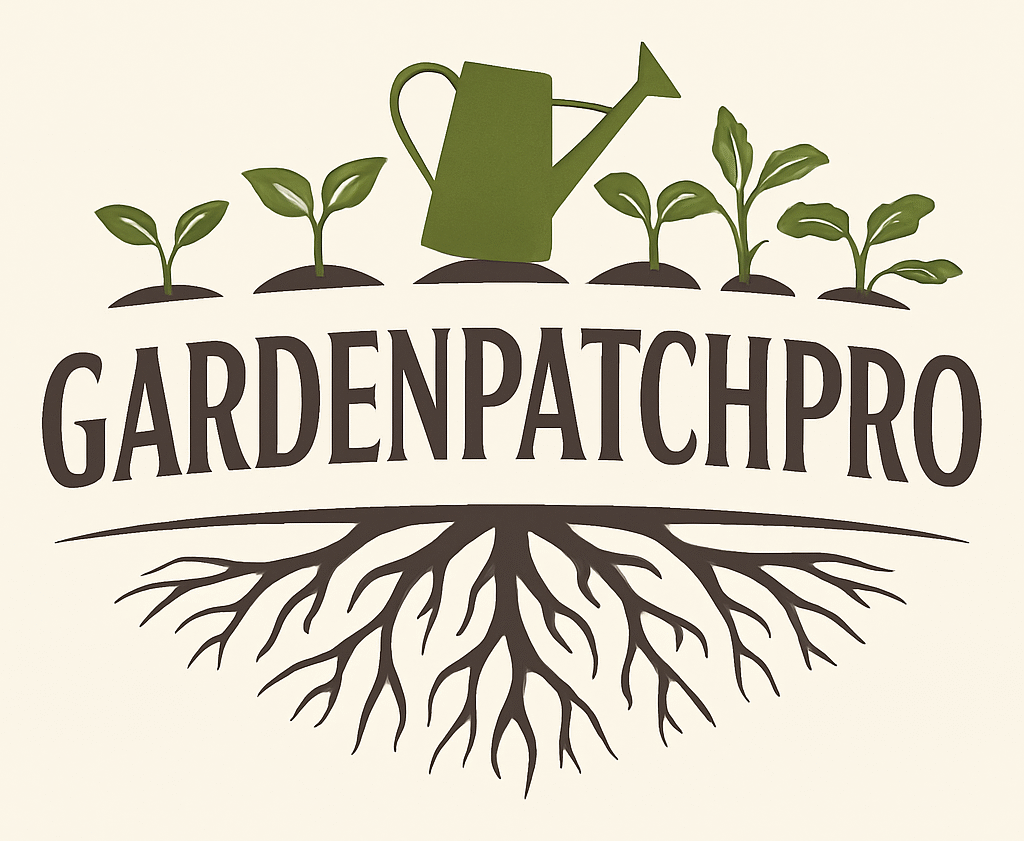16 Privacy Fence Ideas to Enhance Your Outdoor Space With Style and Security
Privacy fences are a practical way to create a more secluded and secure outdoor space. They help block views from neighbors and passersby, making yards feel more private and comfortable. People choose privacy fences to enhance both the look and function of their property.

A well-designed privacy fence provides peace of mind by keeping unwanted eyes away while adding style to the yard. This article shares 16 privacy fence ideas that can suit different needs and preferences. It covers options for various budgets and materials, offering ways to improve any outdoor area.
1) Tall wooden privacy fence with horizontal slats

A tall wooden privacy fence with horizontal slats offers a clean and modern look. It usually stands between 6 to 8 feet tall, giving good coverage from neighbors or street views.
The horizontal slats can be spaced to allow some light and air to pass through while still maintaining privacy. This design works well with cedar or other durable woods that resist weather.
Building this type of fence involves setting strong posts, often concrete-set, to support the weight of the long horizontal boards. The slats are attached evenly across the frame to create a smooth, continuous surface.
This fence style fits many yard types and can be painted or stained to match a home’s exterior. It balances style with function, making it a popular choice for private outdoor spaces.
For more detailed ideas and tips, see horizontal fence designs with photos.
2) Bamboo fencing for a natural, eco-friendly look
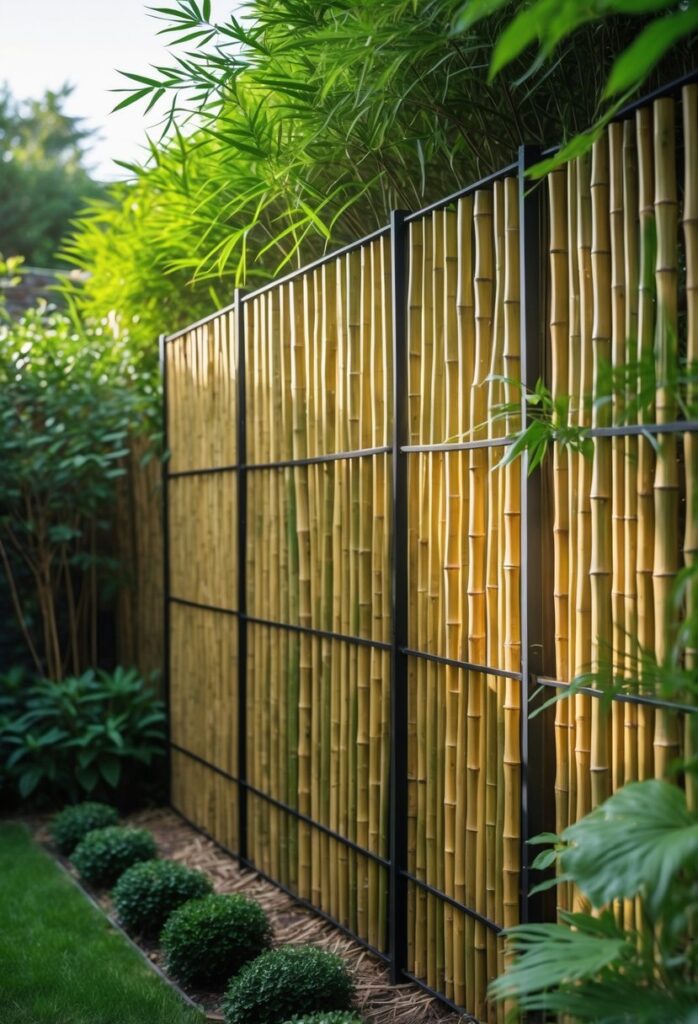
Bamboo fencing offers a simple way to add privacy with a natural feel. It blends well with garden plants and outdoor spaces. This type of fencing creates a calm and inviting atmosphere.
It is also eco-friendly since bamboo grows quickly and needs less water or chemicals than other woods. People who want a low-impact fence often choose bamboo for this reason.
Bamboo fences come in many styles. From sleek and modern to rustic and handcrafted, there are options to suit various tastes. The natural color and texture of bamboo give yards a warm, earthy look.
Besides privacy, bamboo fences can act as windbreaks or garden borders. They are usually durable when treated properly, resisting weather and insects. This makes bamboo fencing practical as well as attractive.
For more inspiration and ideas, detailed bamboo fencing options can be found at 20 bamboo garden fence ideas for a natural, Zen look.
3) Vinyl privacy fence with decorative lattice top
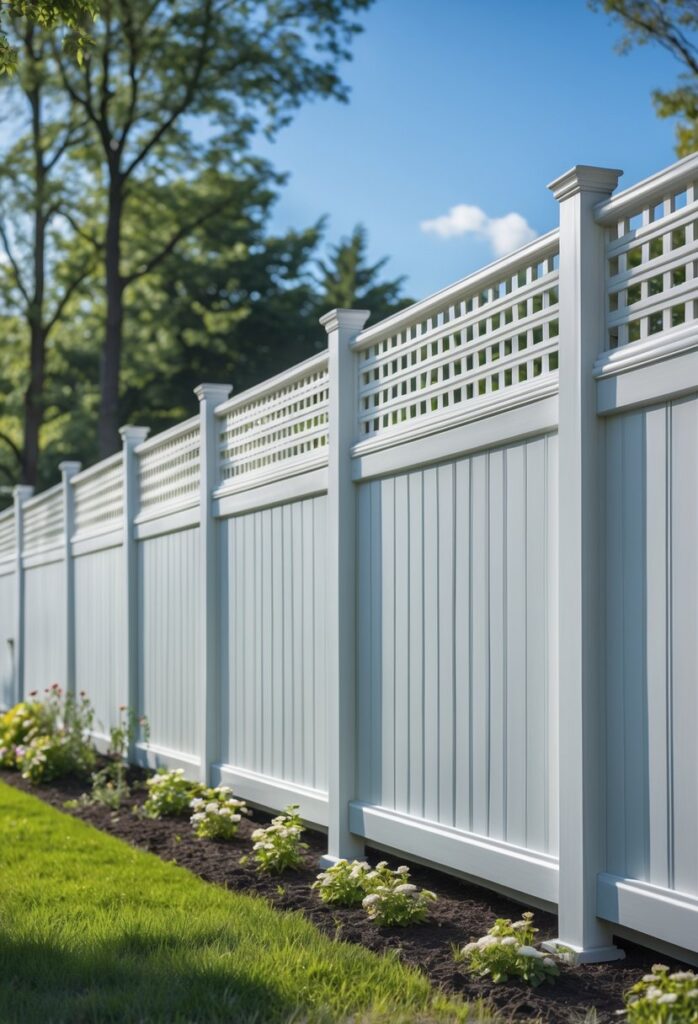
A vinyl privacy fence with a decorative lattice top combines solid panels with a stylish lattice design at the upper section. This design adds visual interest while still providing privacy. The lattice allows some light and air to pass through, making the fence less imposing.
Vinyl is a popular material for these fences because it is durable and low maintenance. It resists weather, fading, and insects better than wood. The lattice top can be made in different patterns, such as square or diamond shapes, to suit various tastes.
This style is also practical. The solid lower panels block views and noise, while the lattice top can support climbing plants like ivy or vines, adding natural beauty to the yard. The lightweight vinyl makes installation easier than heavy wooden panels.
Overall, vinyl privacy fences with decorative lattice tops balance style and function. They enhance curb appeal without sacrificing security or privacy. This type of fence can fit well in many settings, from suburban gardens to modern homes. For more design ideas, see examples of vinyl lattice panels fence ideas.
4) Metal privacy fence with laser-cut patterns
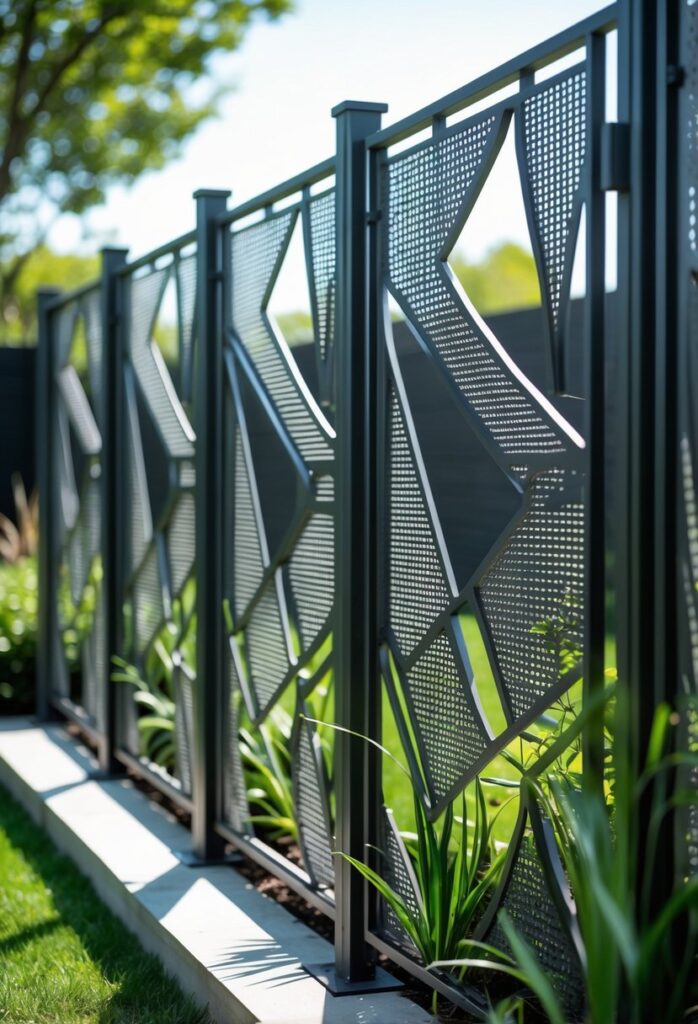
Metal privacy fences with laser-cut patterns offer both security and style. The precise cuts create detailed designs that add a decorative touch without sacrificing privacy. These fences allow light and air to pass through while blocking unwanted views.
They come in many patterns, from geometric shapes to nature-inspired motifs. This variety makes it easy to find a design that fits the home’s style and surroundings.
Laser-cut metal panels are also durable and low maintenance. Made from steel or aluminum, they resist weather and can last for years when properly treated.
Customization is common. Homeowners can order panels with unique patterns tailored to their tastes. This personalization adds a distinctive look to the property.
Using a laser cut metal privacy screen fence can enhance both privacy and curb appeal.
Additionally, applying weatherproof outdoor paint protects the metal and keeps the fence looking good despite exposure to sun and rain. This makes the fence both functional and visually appealing.
5) Stone wall fence for permanent backyard privacy

A stone wall fence provides strong, lasting privacy for a backyard. It is built from natural stone or bricks, making it sturdy against weather and wear over time. This type of fence adds a classic look that fits many outdoor styles.
Stone walls block views and noise, creating a quiet, private space. Because they are heavy and solid, they offer more security compared to lighter fence options.
Building a stone wall fence requires more effort and cost upfront. However, it needs less maintenance once finished. Stone walls do not warp, rot, or require painting.
Homeowners can choose different designs for their stone fences. For example, dry stone walls use stacked stones without mortar, creating a rustic feel. Mortared stone walls appear more polished and formal.
For those interested in a long-term privacy solution, a stone wall fence is a practical and elegant choice. More ideas on this type of fence can be found in the guide to stone wall privacy fences.
6) Pallet wood fence for a DIY budget option
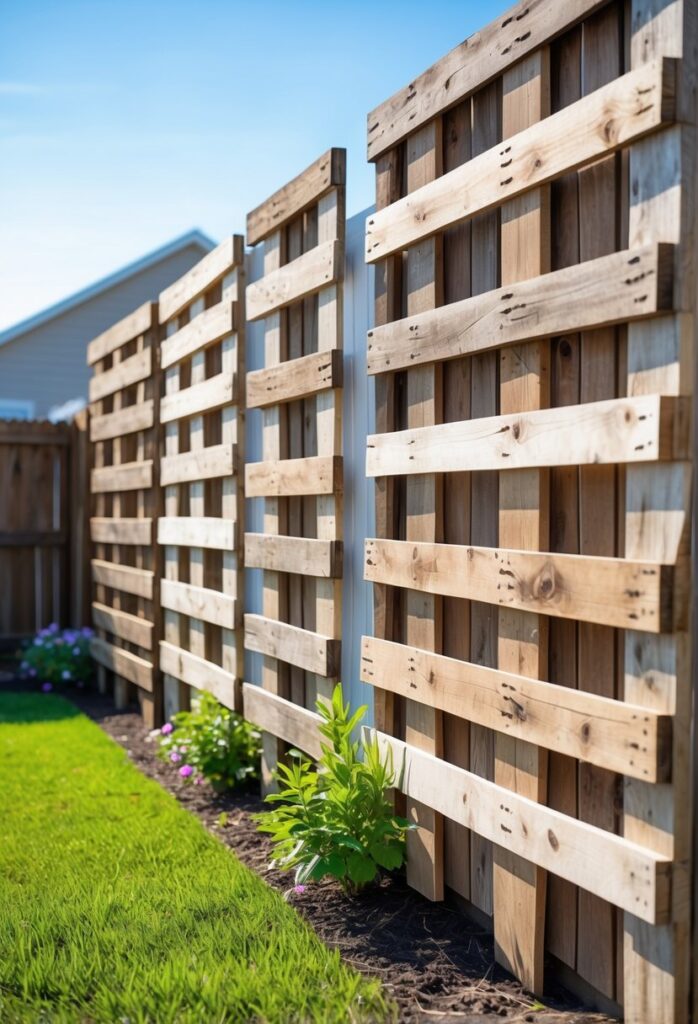
A pallet wood fence is a smart choice for those who want to save money and still add privacy. Pallets are often free or very cheap, making them ideal for budget-friendly fencing projects. They offer a rustic look that fits well in many yards.
Building with pallets is simple. The wood is already cut into boards, so it requires less preparation. People can arrange the pallets side by side or break them down to create custom designs. This flexibility helps fit different yard sizes and styles.
Pallet wood fences are also eco-friendly because they reuse materials. Some pallets may need sanding or treatment to last longer outdoors. Adding a stain or sealant helps protect the wood from weather damage.
This option may not be as durable as other fences but works well for temporary or casual privacy needs. For ideas and step-by-step guides, people can explore DIY pallet fence ideas and how to build one.
7) Living fence using dense evergreen shrubs
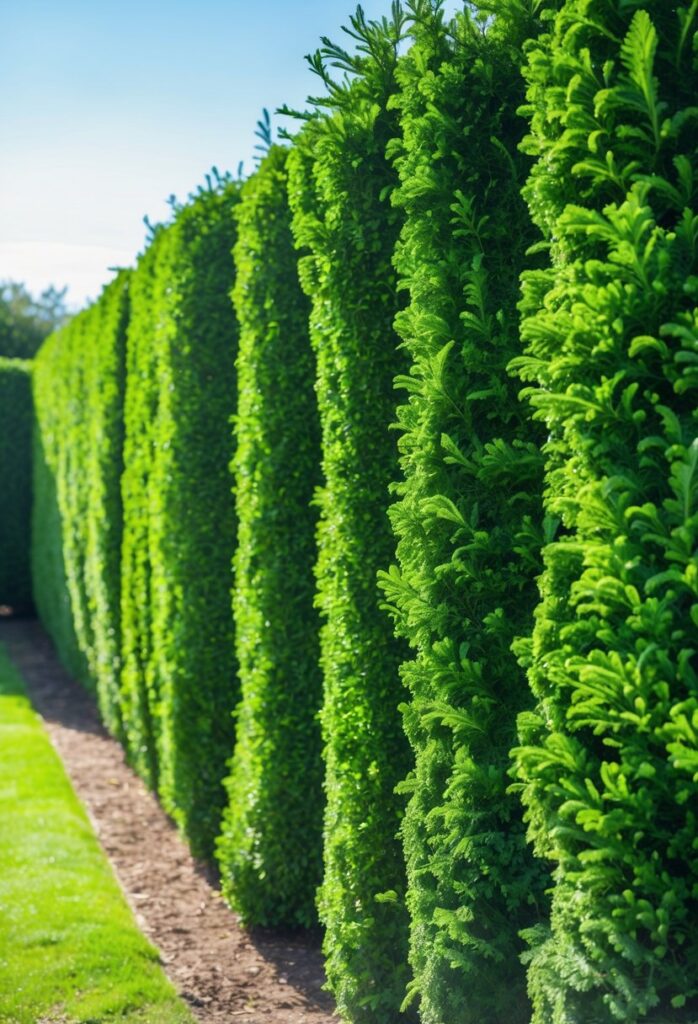
A living fence made from dense evergreen shrubs provides year-round privacy. These shrubs keep their leaves in all seasons, creating a solid natural barrier. This makes them a reliable choice for blocking views and reducing noise.
Evergreens like arborvitae are popular because they grow thick and tall. They adapt well to different soil types and need little maintenance once established. Their dense foliage helps create an attractive, natural fence without gaps.
Planting these shrubs close together forms a continuous hedge. This hedge acts as a windbreak and offers shelter for birds and small wildlife. It also adds greenery that enhances the look of any yard.
Using evergreen shrubs for a living fence is often more cost-effective compared to building traditional fences. They grow slowly but steadily, requiring patience. Over time, the fence becomes stronger and more durable.
More ideas on using shrubs for natural fences can be found in this guide on creating a living privacy fence.
8) Trellis fence with climbing plants
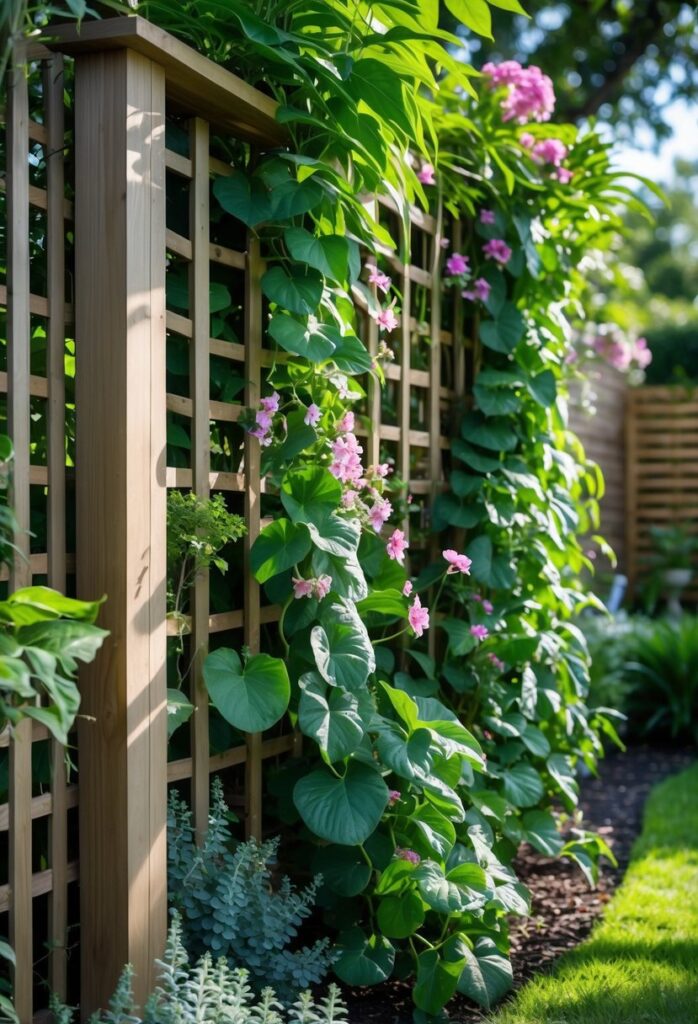
A trellis fence with climbing plants is a practical way to add privacy while enhancing garden beauty. The trellis supports vines and flowers that grow vertically, creating a natural screen.
It works well in small or large yards because it takes up little ground space but adds height and coverage. Plants like ivy, jasmine, and roses are good choices to cover the trellis.
The design can be simple wood or metal. The key is to place it where it blocks unwanted views but still lets light and air through.
Besides privacy, this setup attracts birds and butterflies, adding life to the yard. It also softens the look of fences by adding greenery and color.
For ideas on creating privacy with climbing plants on trellises, resources like the article on privacy trellis ideas with climbing plants offer many helpful tips.
9) Woven willow or hazel hurdles

Woven willow or hazel hurdles are traditional fencing options made by weaving flexible branches. They offer a natural look that fits well in gardens or rural spaces. These fences allow some light and air to pass through, creating a breathable barrier.
Willow hurdles tend to look light and airy, with a warm tone. Hazel hurdles have a cooler color and a stick-like texture. Both materials weather over time, gaining character and a rustic feel.
They are durable and can last several years with little maintenance. Installation is usually simple, involving attaching the hurdles to posts. Their eco-friendly nature makes them a sustainable choice compared to synthetic fences.
These hurdles fit well in exposed areas because they diffuse wind rather than block it completely. They also bring a classic charm to outdoor spaces without sacrificing practicality. This mix of style and function makes woven willow or hazel hurdles a popular choice for privacy fences.
For more about the benefits and styles, see woven fencing guides on sites like Gardenista or Woven Wood.
10) Fence with vertical cedar planks
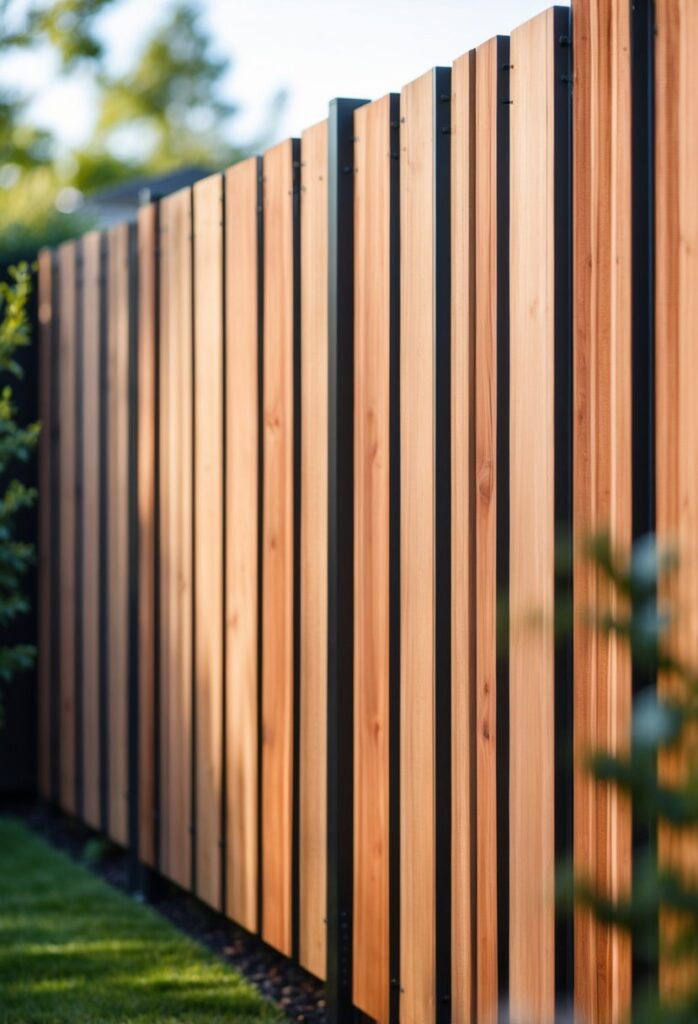
A fence with vertical cedar planks is a popular choice for privacy. The vertical boards create a clean, simple look while providing solid coverage that blocks views. This style works well for many yard shapes and sizes.
Cedar is naturally resistant to pests and weather, making it a durable option. It ages gracefully, often developing a soft silver-gray color if left unstained. Homeowners can choose to stain or leave it natural based on the look they want.
This fence type also offers flexibility in design. Planks can be spaced closely for full privacy or slightly apart for partial visibility. The height can be adjusted easily to meet local privacy and safety rules.
For a more decorative touch, some add lattice tops or varying plank widths. This maintains privacy while adding visual interest. A vertical cedar plank fence combines function with a timeless, natural look. More ideas can be found with this cedar vertical fence inspiration.
11) Gabion stone-filled wire baskets
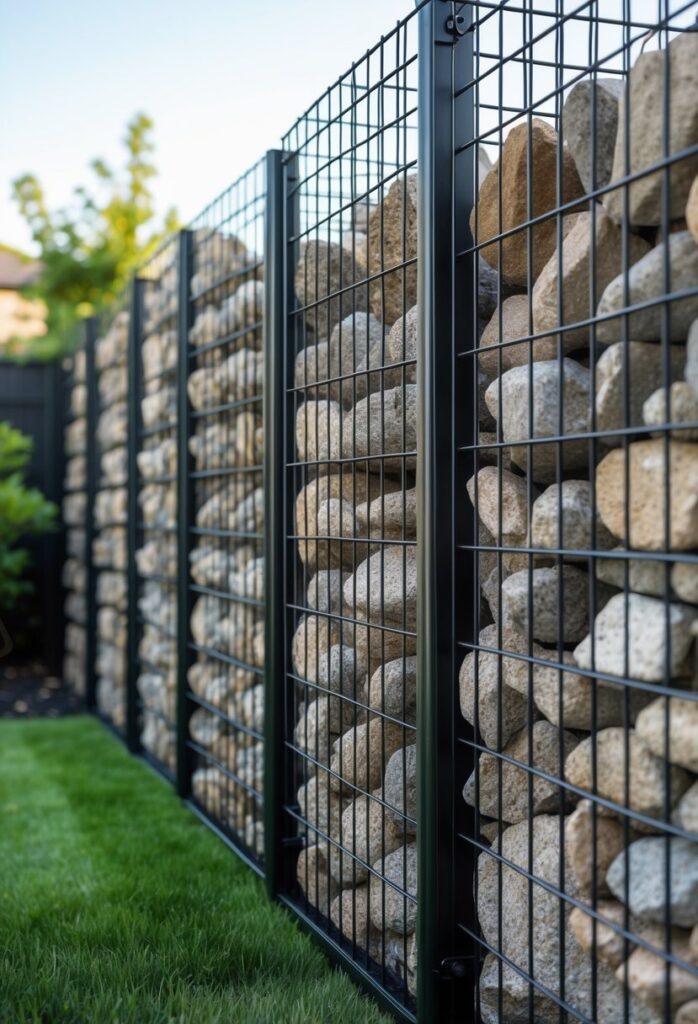
Gabion fences are made from wire baskets filled with stones or gravel. These baskets create a strong, solid barrier that offers both privacy and durability. The wire cage holds the stones tightly, making the fence stable and long-lasting.
They can fit many styles, from modern to rustic. The natural stone gives a textured, earthy look that blends well in gardens and yards. Gabion fences also work as sound barriers, reducing noise from nearby streets or neighbors.
Building a gabion fence is flexible. The baskets come in various sizes and shapes, allowing for custom designs. Adding other materials like wood or metal posts can create contrast and style.
Gabion fences require little maintenance. Stones do not rot or need painting. The wire is usually galvanized to resist rust.
This type of fence is ideal for people wanting strong privacy without a fully solid wall. For visual ideas and building tips, see gabion wall designs and ideas in this Gabion Wall Inspiration and Ideas for Homeowners.
12) PVC fence panels with opaque design
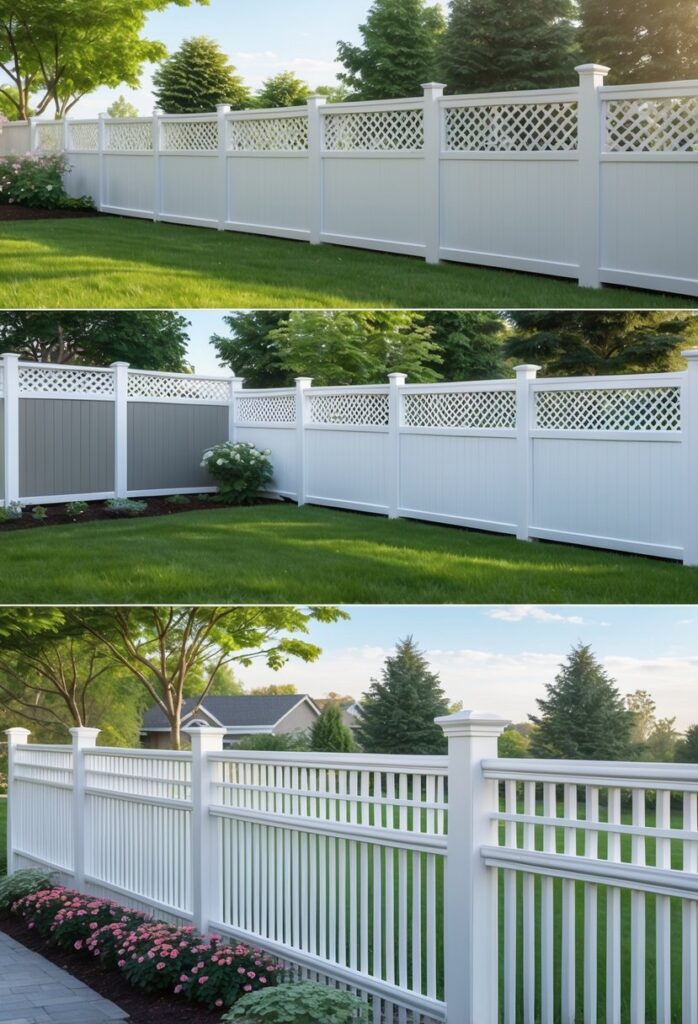
PVC fence panels with an opaque design offer full privacy by blocking the view completely. They are made from durable materials that resist weather, moisture, and insects. This makes them a low-maintenance option for homeowners.
These panels often come in modern styles with clean lines, fitting well with different yard designs. Some models include features for airflow while maintaining full coverage, which helps prevent mold and keeps the area fresh.
Installation is usually straightforward, with lightweight panels that can be set up by DIY enthusiasts. The opaque design helps reduce noise and creates a quiet, secluded space.
PVC fence panels are available in several colors, though white is common. They also often include reinforced rails and posts for extra strength and long-lasting performance. More details about these privacy panels can be found at this site offering privacy PVC fence panel designs.
13) Bamboo screen roll attached to a frame
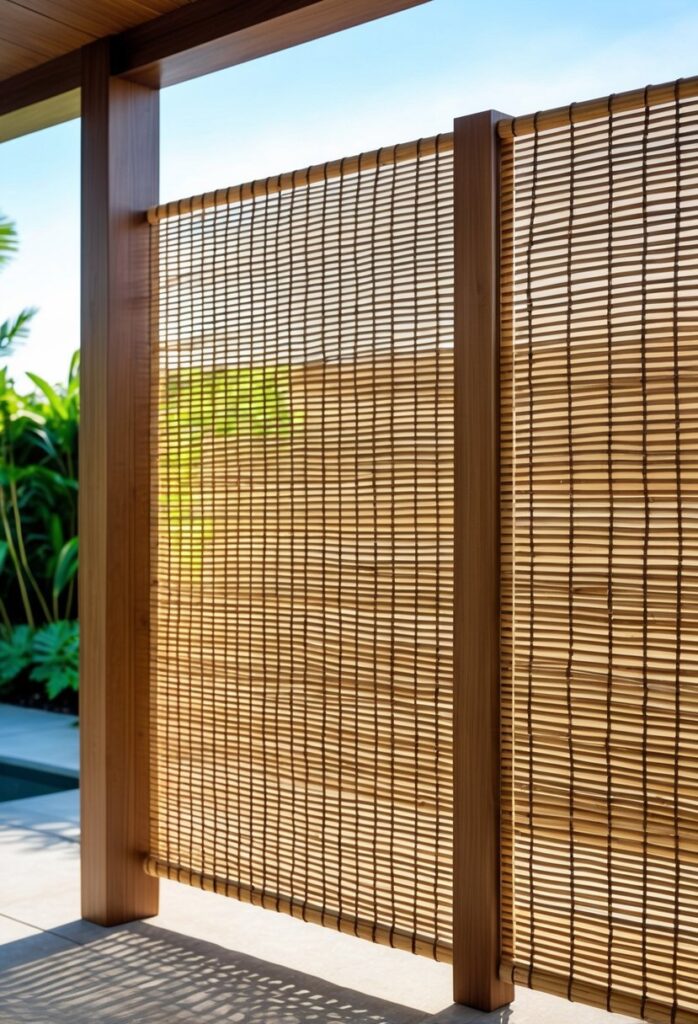
A bamboo screen roll is a practical way to add privacy quickly. It comes in rolls of thin bamboo strips held together with wire or string. This makes it easy to unroll and attach to an existing frame or structure.
The frame can be made from wood, metal, or PVC pipes. Attaching the bamboo screen to the frame usually involves zip ties, wire, or clips. This method keeps the screen secure and stable.
Bamboo screens are lightweight but strong. They provide a natural look that blends well with outdoor spaces. The gaps between bamboo strips allow some light and air to pass through while still offering privacy.
This solution works well for patios, balconies, or gardens. It is affordable and can be reused or moved as needed. For detailed step-by-step help, one can view a guide on how to attach bamboo screening to a fence at EasyMerchant.
14) Composite fencing combining wood and plastic
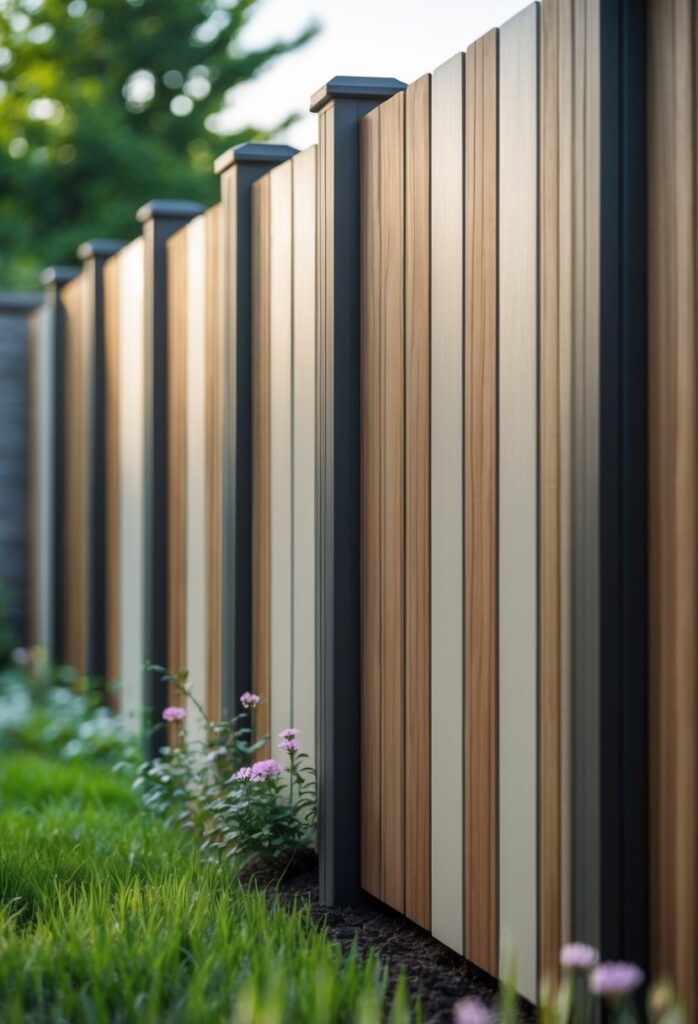
Composite fencing blends wood fibers with plastic to create strong and durable panels. This mix offers the look of natural wood but with less upkeep. It resists rotting, warping, and cracking better than traditional wood fences.
These fences often use recycled materials, making them a more eco-friendly choice. They require very little maintenance—no painting or staining is needed to keep them looking good over time.
Composite panels come in various styles, including board-on-board and lattice tops. This lets homeowners choose designs that fit their privacy needs and aesthetic preferences.
Because of their lasting nature, composite fences can last 25 years or more, which is longer than most wood fences. They are also resistant to insects and weather damage.
The combination of materials makes composite fencing a practical option for those who want durability, ease of care, and a modern appearance. More details on this type of fencing are available at garden.eco’s privacy fence panels ideas.
15) Reed or bamboo roll attached to existing fence
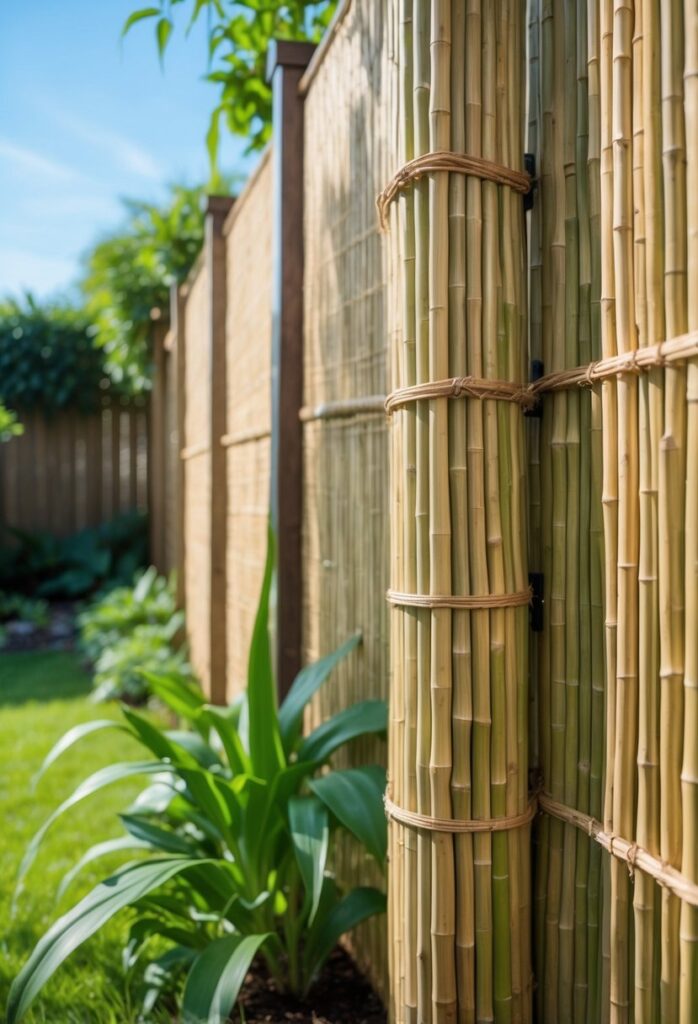
Attaching reed or bamboo rolls to an existing fence is an easy way to add privacy. These rolls come in long strips that can be fastened directly to chain-link or wooden fences. This method covers up old fences and gives a natural look.
The rolls are lightweight but sturdy enough to withstand weather if secured well. It is important to have a firm structure to hold the rolls in place for lasting results. They are often attached using wire, zip ties, or nails.
Bamboo and reed rolls are affordable and can be replaced or adjusted if needed. They provide moderate privacy by blocking views while letting some light and air through. This option is good for small sections or enhancing an existing fence without much work.
For more details on installing rolled bamboo fencing on an existing structure, see how to attach bamboo fencing to a fence.
16) Height-extended classic picket fence

A height-extended classic picket fence offers more privacy while keeping the traditional look. By increasing the height, it blocks sightlines without losing the charm of evenly spaced pickets. This makes it suitable for yards that need extra seclusion but want a welcoming feel.
The design usually keeps the pointed tops and uniform gaps. These fences are often made from wood like cedar, which is durable and easy to paint or stain. The taller structure still allows air and light to pass through, preventing the space from feeling closed in.
Height-extended picket fences work well in front yards and side yards. They can be paired with an arbor or gate to add architectural interest. This style balances function and style for those who want a classic fence that also protects their privacy. For ideas, see 40 impressive garden picket fence ideas.
Choosing the Right Privacy Fence for Your Needs
Selecting a privacy fence depends on factors like property layout, visual appeal, and upkeep. Understanding these details helps match the fence to the space and lifestyle.
Assessing Your Property
The size and shape of the yard are basic starting points. Narrow or irregular spaces may work better with vertical wood fences or slim panels that fit tight areas.
Local rules can limit fence height or style, especially near sidewalks or streets. Checking these regulations avoids future problems.
The fence’s purpose also matters. Is it to block noise, mark boundaries, or keep pets safe? Each goal affects material and design choices.
Balancing Privacy and Style
Privacy fences don’t have to be plain. Horizontal wood fences give a modern look, while classic vertical boards offer a traditional feel.
Materials like composite panels combine privacy with a clean finish and durability. Greenery fences with faux boxwood add a natural touch without gaps.
Colors and trim details can enhance curb appeal. Even tall fences can look inviting with thoughtful styling.
Evaluating Maintenance Requirements
Wood fences often need staining or sealing every few years. This keeps them looking good and prevents rot.
Composite fences require less upkeep but can be more expensive upfront. They resist fading and do not warp.
Metal posts combined with wood slats add strength and need minimal care. Choosing the right combination balances effort and longevity.
For easy DIY options, pallet fences offer quick assembly but may need more frequent repairs. Evaluating maintenance helps pick a fence that fits the owner’s time and budget.
For more privacy fence ideas, see 16 Excellent Privacy Fence Ideas.
Legal Considerations and Installation Tips
Building a privacy fence requires attention to rules, property boundaries, and installation quality. These factors help avoid legal problems and ensure the fence stands strong over time.
Understanding Local Regulations
Before installing a fence, it is essential to check local building codes and zoning laws. Many cities and towns set limits on fence height, materials, and placement.
Homeowners should contact their city or county office to find out specific rules. Some areas need permits before construction begins, and others may require inspections after installation.
Ignoring these rules can lead to fines or being forced to remove the fence. It’s also smart to review any homeowners association (HOA) guidelines, which often have extra requirements.
Setting Property Lines
Knowing the exact location of property lines is critical to avoid disputes with neighbors. A fence placed off the property may lead to legal issues or demands for removal.
Hiring a professional land surveyor to mark the boundaries is the safest option. A clear survey helps plan the fence layout and prevents mistakes.
If a survey is not possible, neighbors should discuss and agree on fence placement. This prevents misunderstandings and maintains good relationships.
Hiring Professional Installers
While some fences are DIY-friendly, hiring professional installers can save time and ensure quality work. Professionals understand local codes and proper construction techniques.
They will identify any underground utilities to avoid damage during installation. Professionals also have the right tools to dig post holes deep enough for stability.
Costs vary depending on fence type and property size. However, a well-installed fence typically lasts longer and requires less maintenance than a poorly built one.
For more detailed tips on building a privacy fence, see this privacy fence building guide.
Frequently Asked Questions
Privacy fences can be built using a variety of materials and designs to balance cost, height, and style. Choosing the right options depends on budget, desired privacy level, and the outdoor space’s overall look.
What are some cost-effective materials for building a privacy fence?
Wood is one of the most affordable materials and offers flexibility in design. Bamboo is another budget-friendly choice that provides a natural appearance and eco-friendly option.
Vinyl fences generally have a higher upfront cost but require less maintenance, making them cost-effective over time.
How can I create a tall privacy barrier for my backyard?
Using tall wooden fences with horizontal slats is an effective way to increase privacy. You can also build a stone wall fence, which offers sturdy and permanent privacy.
Adding lattice tops to vinyl fences can add height without making the fence feel too imposing.
What are unique design options for a DIY privacy fence?
Laser-cut metal fences add an artistic touch while maintaining privacy. Bamboo fencing brings in a natural look that is easy to install.
Horizontal slats on wooden fences create a modern aesthetic, while decorative lattice can provide pattern and style.
What are some creative privacy fence ideas for outdoor spaces?
Mixing materials, such as pairing wood with metal panels, can boost visual interest. Incorporating greenery alongside fences enhances privacy and adds softness.
Using bamboo or stone walls turns the fence into a focal point. Decorative fence tops like lattice work create a stylish finish.
How can I construct a privacy fence without overspending?
Choosing materials like wood or bamboo keeps costs down. DIY installation of simple designs like horizontal wood slats can save money.
Avoid ornate or heavy materials unless budget allows. Planning for basic but effective styles helps control expenses.
What are the regulations regarding maximum fence height for residential areas?
Fence height limits vary by location but often range between 6 to 8 feet for backyard privacy fences. Checking local building codes before construction ensures compliance.
Some areas require permits for fences taller than a set height, usually 6 feet. It is important to review neighborhood rules to avoid fines.
